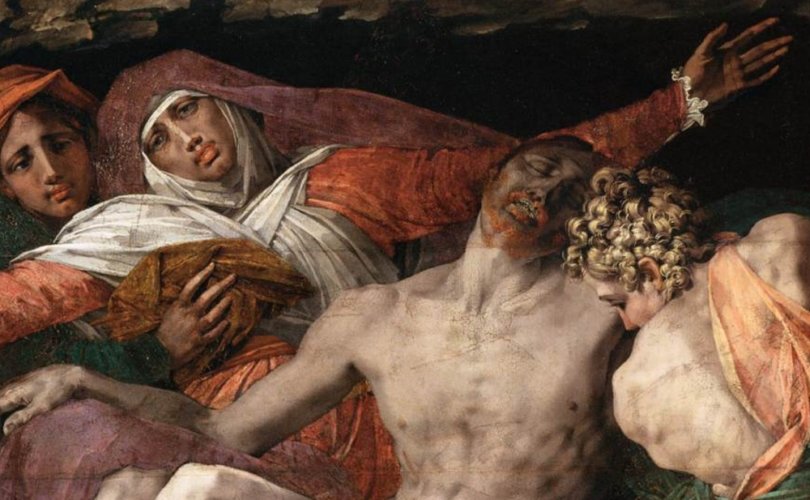October 2, 2018 (LifeSiteNews) – In this week’s art column I would like to speak of the 16th-century movement known as “mannerism.” In order to do so, we must first remind ourselves of the qualities of the High Renaissance (ca. 1495–1520), namely, balance, symmetry, harmony, lucidity; at times, placidity, tenderness, reassurance. We see these qualities in the quintessential High Renaissance painter, Raphael: he is not sharp, aggressive, or overly “realistic,” but smooth, gentle, and idealistic. This was the “Platonic” painting that was the natural culmination of Renaissance humanism: the perfect human form as the revelation of man’s dignity and the beautiful cosmic order created by God.
The loose movement known as mannerism shook up this too-perfect world, which, perhaps, could not have lasted long. While the successors of the High Renaissance artists learned the very same techniques and had all their skill, they often chose to go in a different direction, away from sweet orderliness. They exaggerated features, heightened the (often unflattering) realism, favored confusion and asymmetry, depicted intense emotion, and preferred the striking, bizarre, or unexpected over the natural and well-formed. They also toned down their colors, preferring scenes where objects seem to blend and merge.
Artists of this movement or trend would include Pontormo, Bronzino, Romano, Parmigianino, Titian (in his late phase), Tintoretto, and—the subject of today’s column—Giovanni Battista di Jacopo (1495–1540), called “Rosso Fiorentino” or “the red Florentine” by his contemporaries.
Rosso Fiorentino’s Pietà, which he produced at the very end of his life, 1538–40, hangs today in the Louvre in Paris. It is a striking painting for so many reasons. The figures are brilliantly arranged to maximize the sense of restless motion around the Christ resting in death. They are heavily clothed to accentuated his nakedness, the shameful exposure of His flesh to the scorn of His enemies. The insistent, almost obsessive use of a reddish-orange color suggests a pool of blood, an arhythmical circulation of lifeblood, underscoring the redemption now accomplished by the Savior, in spite of every appearance of loss and defeat.
The Mother of the Lord throws her arms out in a gesture of lamentation for her Son and surrender to the Father, emotional exhaustion, even perhaps intercession, and certainly appeal to us to enter into her sorrows. She is, in fact, a perfect representation of Holy Mother Church in the face of the (temporary but no less horrible) defeat of goodness and triumph of wickedness in high places.
St. John supports her gently, with a misery on his face too deep for tears or words, yet with an expression of resignation, acceptance, and trust. St. Mary Magdalen, repentant in soul though still beautifully arrayed (what a contrast to Christ!), seems the most at peace as she cradles the feet of her Master who turned her life upside down. As she assumes the humblest position and assists in laying the sacred body of Christ to rest on a strangely out-of-place cushion in front of a gaping cave, she is near to that most elusive and most coveted spiritual condition—peace. “In His will is our peace.” Even when He is crushed, she seems to be saying, “I know that my Redeemer liveth,” or rather, that He will live again. Life itself cannot long be held by Death.
Note: Article continues beneath this image.

What are the mannerist features that makes this painting so arresting? Given the consistency of Fiorentino’s style, the following description of the same artist’s Deposition applies equally well to the Pietà:
Instead of moving slowly and carefully back into space, the forms all appear on the same plane. The muscular bodies of the agitated figures recall Michelangelo, but the draperies have brittle, sharp-edged planes. The low horizon line sets the figures against a dark sky, creating a disquieting effect. The colors are not primaries but sharply contrasting, and the brilliant light seems to fall on the bodies irrationally. Unlike the orderly calm and deep space of Leonardo’s The Last Supper, Rosso creates an unstable composition within a compressed space staffed by figures that move frantically to lower the body of Christ. Only Christ’s figure appears serene in the midst of this emotionally charged image. (Janson’s History of Art)
While the word “frantic” does not seem to characterize these figures, undoubtedly they are distraught and restless, performing a corporal work of mercy for the Lord of mercy Himself. Through its strange colors, its busyness, its immediacy and density, it is, indeed, a disquieting work.
It is, to my mind, a work that speaks to our contemporary situation with breathtaking realism. What has become of Christ in our modern world? Has He not been stripped and put to death in the public square? Has He not been carried limply to a tomb, as if His mission is at an end, and all is over and done? Do not the rulers of this present darkness boast of their supposed triumph, believing in their pride that they no longer need Our Lord, His Blood, His teaching, His kingship—that they are even “liberated” from God and religion?
Yes, all this is truly where we stand. But we know in faith, and we have seen again and again in the history of the Mystical Body of Christ, that “Thou wilt not allow Thy Holy One to undergo corruption.” Christ could not be conquered by sin, death, hell, or Satan; His resurrection demonstrated the ultimate powerlessness of evil over God and all who belong to Him. So it is and will be with us, if we remain united to God in charity and sanctifying grace.
Note: Follow LifeSite's new Catholic twitter account to stay up to date on all Church-related news. Click here: @LSNCatholic


